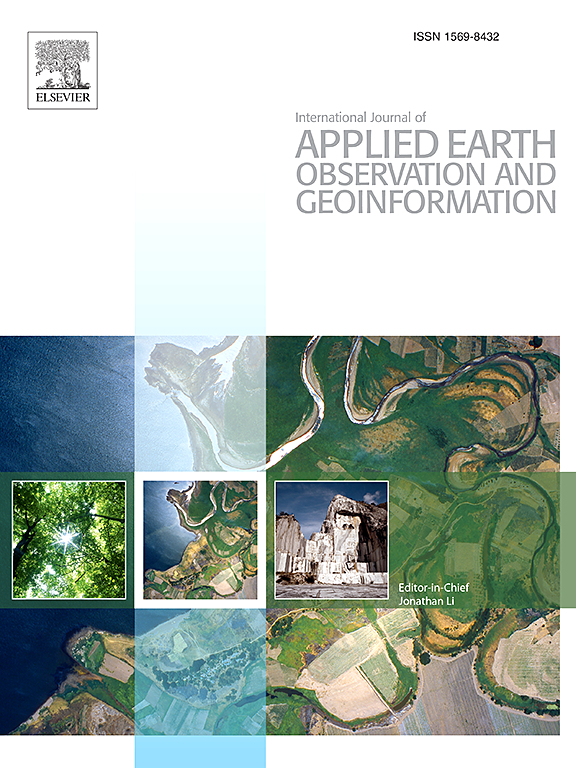利用低脉冲密度激光雷达和卫星遥感估算人工林相对产量指数特征
IF 7.6
Q1 REMOTE SENSING
International journal of applied earth observation and geoinformation : ITC journal
Pub Date : 2025-04-25
DOI:10.1016/j.jag.2025.104558
引用次数: 0
摘要
在日本,对森林管理的需求增加,特别是对森林砍伐的需求增加,是人工林老化的直接后果。然而,日本的森林清查(FI)缺乏关于森林发育阶段或生态状况的关键细节,往往只提供树种、年龄和所有者信息。相对产量指数(Ry)是日本林业广泛使用的森林密度指数。它可以结合树高数据计算出树密度、胸高径、材积和胸高基面积作为林分尺度。虽然它是森林管理的一个有价值的指标,但没有关于在大空间尺度上估算它的研究报告。因此,在本研究中,我们旨在结合卫星图像和航空光探测和测距(LiDAR)数据,在广阔的林分尺度上估算日本雪松和柏树人工林的Ry,这些数据具有良好的垂直分辨率。地表温度对森林密度差异很敏感,数据来自Landsat8卫星图像。考虑到地表温度高度依赖于地形,我们利用地表温度数据和数字高程模型开发了一个地形感知的归一化地表温度指数(ΩST)。利用Landsat获得的增强植被指数估算叶面积指数(LAI),与Ry呈正相关关系。开发了标准化的LAI (ΩLAI)来处理归因于树高的LAI差异。利用ΩST和ΩLAI计算得到的Ry估计指数(Ry_estimated)与LiDAR数据估算得到的Ry(相关系数;R = 0.61-0.65),证实其精度较高(均方根误差;Rmse = 0.07-0.11)。将该方法应用于日本关东地区3650 km2的人工杉柏林中,获得了各种森林特征的大尺度和详细信息。该方法从激光雷达获取树木高度数据,从卫星图像提取森林密度信息。激光雷达数据和卫星图像的结合有可能提高基于森林估算的准确性,降低数据获取成本,并提高创建和更新fi的效率。本文章由计算机程序翻译,如有差异,请以英文原文为准。

Estimating characteristics of planted forests’ relative yield index using low pulse density LiDAR and satellite remote sensing
The increased demand for forest management, particularly thinning, in Japan is a direct consequence of aging planted forests. However, forest inventories (FI) in Japan lack crucial details regarding the developmental stage or ecological status of forests, often only providing tree species, age, and owner information. The relative yield index (Ry) is a forest density index widely used in the forestry industry in Japan. It can be combined with tree height data to calculate tree density, diameter at breast height, timber volume, and basal area at breast height as the stand scale. Although Ry is a valuable indicator for forest management, no studies have been reported on its estimation over a large spatial scale. Therefore, in this study, we aimed to estimate the Ry of planted Japanese cedar and cypress forests at the stand scale over a large area by combining satellite imagery and airborne light detection and ranging (LiDAR) data, which offer excellent vertical resolution.
Data on surface temperature, which is sensitive to differences in forest density, was obtained from Landsat8 satellite imagery. Considering that surface temperature is highly dependent on topography, we developed a topography-aware normalized surface temperature index (ΩST) using surface temperature data and a digital elevation model. The leaf area index (LAI), which was positively correlated with Ry, was estimated from the enhanced vegetation index obtained from Landsat. A normalized LAI (ΩLAI) was developed to address differences in LAI attributable to tree height. The Ry estimation index (Ry_estimated) calculated using ΩST and ΩLAI was correlated with the Ry estimated from LiDAR data (correlation coefficient; r = 0.61–0.65), confirming its high accuracy (root mean square error; RMSE = 0.07–0.11). By applying this method to a 3,650 km2 area of planted Japanese cedar and cypress forests in the Kanto region of Japan, large-scale and detailed information on various forest characteristics was obtained. This method derives tree height data from LiDAR and extracts forest density information from satellite imagery. The combination of LiDAR data and satellite imagery potentially enhances the accuracy of forest-based estimates, reduces data acquisition costs, and improves the efficiency of creating and updating FIs.
求助全文
通过发布文献求助,成功后即可免费获取论文全文。
去求助
来源期刊

International journal of applied earth observation and geoinformation : ITC journal
Global and Planetary Change, Management, Monitoring, Policy and Law, Earth-Surface Processes, Computers in Earth Sciences
CiteScore
12.00
自引率
0.00%
发文量
0
审稿时长
77 days
期刊介绍:
The International Journal of Applied Earth Observation and Geoinformation publishes original papers that utilize earth observation data for natural resource and environmental inventory and management. These data primarily originate from remote sensing platforms, including satellites and aircraft, supplemented by surface and subsurface measurements. Addressing natural resources such as forests, agricultural land, soils, and water, as well as environmental concerns like biodiversity, land degradation, and hazards, the journal explores conceptual and data-driven approaches. It covers geoinformation themes like capturing, databasing, visualization, interpretation, data quality, and spatial uncertainty.
 求助内容:
求助内容: 应助结果提醒方式:
应助结果提醒方式:


